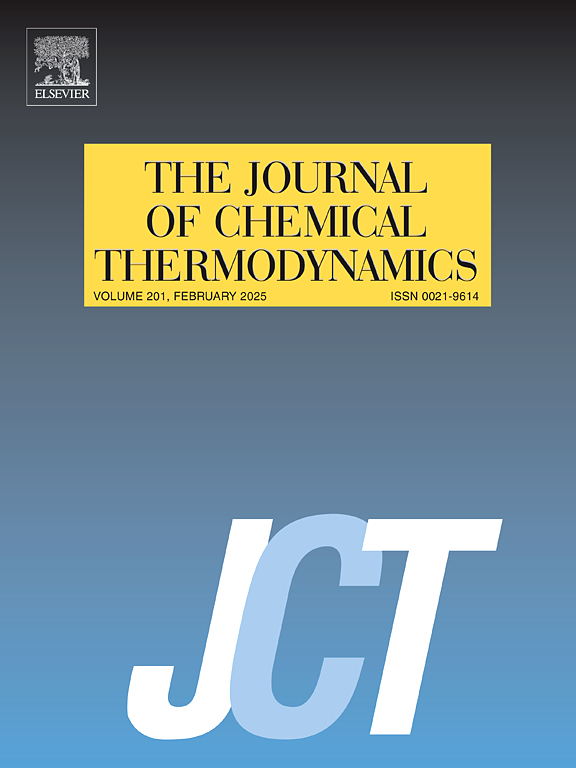Oiling out and solubility measurement, molecular simulation and thermodynamic properties of d-tagatose in four aqueous binary solvent systems at 283.15 to 323.15 K
IF 2.2
3区 工程技术
Q3 CHEMISTRY, PHYSICAL
引用次数: 0
Abstract
Solubility of D-Tagatose in four aqueous binary solvent systems from 278.15 K to 323.15 K was determined using the anti-solvent assisted gravimetric method. The solubility increases with temperature in all four binary solvents, with water, a good solvent, exhibiting a similar trend. In addition, the dissolution process generally follows the ’like dissolves like’ rule. The study indicates that the oiling out occurs when water exhibits a high molar fraction in water + 1-propanol, and water + isopropanol. Furthermore, we study the charge of the molecule using the molecular electrostatic potential surface (MEPS), aiming to analyze the molecular interactions. Then, to explain the dissolution behaviors of D-tagatose, the radial distribution function (RDF) by molecular dynamics simulations (MD) revealed a strong correlation between solute–solvent interactions and solubility, with significant solvent–solvent interactions. The solubility data was correlated using the modified Apelblat equation, Van’t Hoff equation, λh equation, and Jouyban-Acree model, with demonstrating the high consistency in the data. Finally, the thermodynamic properties revealed that the dissolution process of D-Tagatose is endothermic, and entropy-driven based on all positive values for , , .
283.15 至 323.15 K 温度下 d-塔格糖在四种水性二元溶剂体系中的出油和溶解度测量、分子模拟和热力学性质
采用反溶剂辅助重量法测定了 D-塔格糖在 278.15 K 至 323.15 K 四种水性二元溶剂体系中的溶解度。在所有四种二元溶剂中,溶解度都随温度升高而增加,而作为良好溶剂的水也表现出类似的趋势。此外,溶解过程一般遵循 "同类相溶 "的规则。研究表明,当水+1-丙醇和水+异丙醇中水的摩尔分数较高时,就会出现出油现象。此外,我们还利用分子静电位面(MEPS)研究了分子的电荷,旨在分析分子间的相互作用。然后,为了解释 D-塔格糖的溶解行为,分子动力学模拟(MD)的径向分布函数(RDF)显示了溶质-溶剂相互作用与溶解度之间的强相关性,其中溶剂-溶剂相互作用显著。利用改进的 Apelblat 方程、Van't Hoff 方程、λh 方程和 Jouyban-Acree 模型对溶解度数据进行了关联分析,结果表明数据具有很高的一致性。最后,热力学性质表明 D-塔格糖的溶解过程是内热和熵驱动的,ΔsolHo、ΔsolSo、ΔsolGo 均为正值。
本文章由计算机程序翻译,如有差异,请以英文原文为准。
求助全文
约1分钟内获得全文
求助全文
来源期刊

Journal of Chemical Thermodynamics
工程技术-热力学
CiteScore
5.60
自引率
15.40%
发文量
199
审稿时长
79 days
期刊介绍:
The Journal of Chemical Thermodynamics exists primarily for dissemination of significant new knowledge in experimental equilibrium thermodynamics and transport properties of chemical systems. The defining attributes of The Journal are the quality and relevance of the papers published.
The Journal publishes work relating to gases, liquids, solids, polymers, mixtures, solutions and interfaces. Studies on systems with variability, such as biological or bio-based materials, gas hydrates, among others, will also be considered provided these are well characterized and reproducible where possible. Experimental methods should be described in sufficient detail to allow critical assessment of the accuracy claimed.
Authors are encouraged to provide physical or chemical interpretations of the results. Articles can contain modelling sections providing representations of data or molecular insights into the properties or transformations studied. Theoretical papers on chemical thermodynamics using molecular theory or modelling are also considered.
The Journal welcomes review articles in the field of chemical thermodynamics but prospective authors should first consult one of the Editors concerning the suitability of the proposed review.
Contributions of a routine nature or reporting on uncharacterised materials are not accepted.
 求助内容:
求助内容: 应助结果提醒方式:
应助结果提醒方式:


